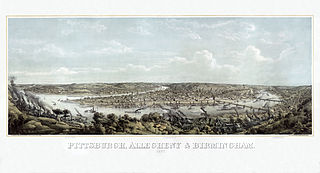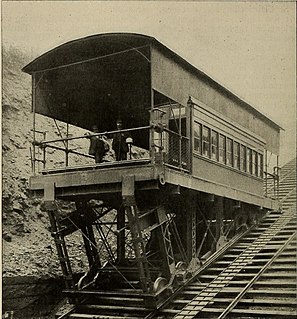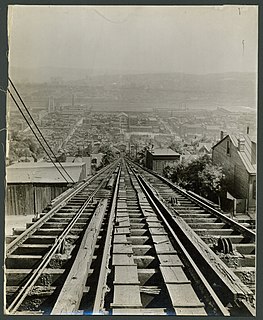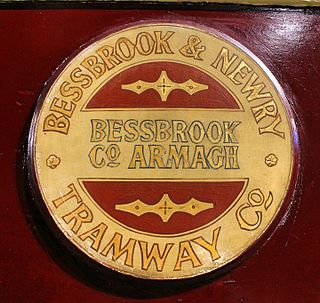Related Research Articles

A cable car is a type of cable railway used for mass transit in which rail cars are hauled by a continuously moving cable running at a constant speed. Individual cars stop and start by releasing and gripping this cable as required. Cable cars are distinct from funiculars, where the cars are permanently attached to the cable.

A locomotive or engine is a rail transport vehicle that provides the motive power for a train. If a locomotive is capable of carrying a payload, it is usually rather referred to as a multiple unit, motor coach, railcar or power car; the use of these self-propelled vehicles is increasingly common for passenger trains, but rare for freight.

The Interurban is a type of electric railway, with streetcar-like electric self-propelled rail cars which run within and between cities or towns. They were very prevalent in North America between 1900 and 1925 and were used primarily for passenger travel between cities and their surrounding suburban and rural communities. The concept spread to countries such as Japan, the Netherlands, Switzerland, Belgium and Poland. Interurban as a term encompassed the companies, their infrastructure, their cars that ran on the rails, and their service. In the United States, the early 1900s interurban was a valuable economic institution. Most roads between towns and many town streets were unpaved. Transportation and haulage was by horse-drawn carriages and carts. The interurban provided reliable transportation, particularly in winter weather, between the town and countryside. In 1915, 15,500 miles (24,900 km) of interurban railways were operating in the United States and, for a few years, interurban railways, including the numerous manufacturers of cars and equipment, were the fifth-largest industry in the country. By 1930, most interurbans in North America were gone with a few surviving into the 1950s.

The Fell system was the first third-rail system for railways that were too steep to be worked by adhesion on the two running rails alone. It uses a raised centre rail between the two running rails to provide extra traction and braking, or braking alone. Trains are propelled by wheels or braked by shoes pressed horizontally onto the centre rail, as well as by the normal running wheels. Extra brake shoes are fitted to specially designed or adapted Fell locomotives and brake vans, and for traction the locomotive has an auxiliary engine powering horizontal wheels which clamp onto the third rail. The Fell system was developed in the 1860s and was soon superseded by various types of rack railway for new lines, but some Fell systems remained in use into the 1960s. The Snaefell Mountain Railway still uses the Fell system for (emergency) braking, but not for traction.

A cable railway is a railway that uses a cable, rope or chain to haul trains. It is a specific type of cable transportation.

Streetcars in Washington, D.C. transported people across the city and region from 1862 until 1962.

Knoxville is a neighborhood in southern Pittsburgh, Pennsylvania. It is part of zip code 15210, and has representation on Pittsburgh City Council by the council member for District 3.
The Rock Creek Railway was one of the first electric streetcar companies in Washington, D.C., and the first to extend into Maryland. It was incorporated in 1888 and started operations in 1890. After expansion, the line ran from the Cardoza/Shaw neighborhood of D.C. to Chevy Chase Lake, Maryland. On September 21, 1895, Rock Creek Railway purchased the Washington and Georgetown Railroad Company and the two formed the Capital Traction Company.

The Pittsburgh Light Rail is a 26.2-mile (42.2 km) light rail system in Pittsburgh, Pennsylvania and surrounding suburbs. It operates as a deep-level subway in Downtown Pittsburgh, but runs mostly at-grade in the suburbs south of the city. The system is largely linear in a north-south direction, with one terminus just north of Pittsburgh's central business district and two termini in the South Hills. The system is owned and operated by the Port Authority of Allegheny County. It is the successor system to the streetcar network formerly operated by Pittsburgh Railways, the oldest portions of which date to 1903. The Pittsburgh light rail lines are vestigial from the city's streetcar days, and is one of only three light rail systems in the United States that continues to use the Pennsylvania Trolley (broad) gauge rail on its lines instead of 4 ft 8+1⁄2 instandard gauge. Pittsburgh is one of the few North American cities that have continued to operate light rail systems in an uninterrupted evolution from the first-generation streetcar era, along with Boston, Cleveland, New Orleans, Newark, Philadelphia, San Francisco and Toronto.

In 1763, King George III provided John Ormsby approximately 2,400 acres (9.7 km2) along the south bank of the Monongahela River as payment for his services during the French and Indian War. The land was then divided into four boroughs: South Pittsburgh, Birmingham, East Birmingham, and Ormsby. The four boroughs were annexed into the City of Pittsburgh in 1872. These areas, collectively, provided for the foundation of the South Side as it is known today.

The Knoxville Incline was a broad gauge inclined railway that ran between Pittsburgh's South Side and Allentown neighborhoods. The incline was constructed in 1890 and had a track gauge of 9 feet (2,700 mm). The charter was in planning as of January 1890, with a target filing date of February 8 of that year, and was originally to be called the Arlington Avenue Inclined Plane. The last day of service was December 3, 1960. It was demolished in 1960. It was designed by John H. McRoberts, with a length of 2644 feet. The Knoxville Incline briefly controlled the Pittsburgh, Knoxville & St. Clair Electric Railroad, while itself being later controlled by Pittsburgh Railways. During its operation, the incline ferried people and freight between the South Side and Knoxville. The Knoxville Incline and the nearby Mount Oliver Incline enabled the development of land in Allentown and surrounding communities on the hilltop. Like the Nunnery Hill Incline, the Knoxville Incline featured a curve, an unusual engineering feat for an incline.

The Metropolitan Railroad was the second streetcar company to operate in Washington, D.C., United States. It was incorporated and started operations in 1864, running from the Capitol to the War Department and along H Street NW in downtown. It added lines on 9th Street NW, on 4th Street SW/SE, along Connecticut Avenue to Dupont Circle, to Georgetown, to Mt. Pleasant and north along Georgia Avenue. In the late 19th Century it was purchased by the Washington Traction and Electric Company and on February 4, 1902, became a part of the Washington Railway and Electric Company.
The Keeling Coal Company (1861-1878) was a 19th-century coal mining company in Allegheny County, Pennsylvania. Its mines were located in the Pittsburgh Coalfield of western Pennsylvania.

Mount Washington Transit Tunnel is an important public transportation link in Pittsburgh, Pennsylvania, United States. The approximately 3,500-foot (1,100 m) tunnel connects Station Square to South Hills Junction, and is used only by Pittsburgh Light Rail cars and buses of the Port Authority of Allegheny County. With the cessation of bus service on the Downtown Seattle Transit Tunnel in 2019, the Mount Washington Transit Tunnel is the only tunnel in the United States to operate both bus and rail services.

The Castle Shannon Incline was a funicular railroad in Pittsburgh, Pennsylvania. It was originally part of the Pittsburgh and Castle Shannon Railroad route to the suburb of Castle Shannon. It replaced an earlier incline dating to 1825 that brought coal down from a mine in Mount Washington.

The Mount Oliver Incline was a funicular on the South Side of Pittsburgh, Pennsylvania. It was designed in 1871 by the Prussian-born engineer John Endres and his American daughter Caroline Endres, one of the first women engineers in the United States.
The St. Clair Incline, also known as the South Twenty-second Street Incline, was built in 1886–1888 and operated by St. Clair Incline Plane Company. It was a double track incline on the South Side Slopes of Pittsburgh from Josephine St. to Salisbury St. The lower station was near the intersection of S. 22nd Street and Josephine. The upper station was on Salisbury Street across from the former Fort Laughlin site eventually occupied by Arlington Playground. The incline was 2,060 ft (628 m) long, with a vertical rise of 361 ft (110 m). It was designed by engineer J. H. McRoberts. As it carried both freight and passengers over steep tracks laid on the ground, it could be considered to be a cable railway. Its path was not of constant slope but became progressively steeper toward the top, tracing a parabolic arc. It is uncertain exactly when the incline closed permanently, but it was reported as shut down in a 1932 Associated Press article about the "passing" of Pittsburgh's inclines. The structure was dismantled in 1934.

The Bessbrook and Newry Tramway operated a 3 ft narrow gauge, hydro-electrically powered tramway transporting passengers and freight between Bessbrook and Newry in Northern Ireland between 1885 and 1948.
References
- ↑ A digest of the acts of Assembly relating to, and the general ordinances of the city of Pittsburgh from 1804 to Sept. 1, 1886. Harrisburg: Edwin K Meyers. 1887. p. 534. Retrieved July 31, 2010.
- ↑ "Life in Western Pennsylvania 1840-1970".
- ↑ "A passing embarrassment". Pittsburgh Press. Pittsburgh. March 30, 1888. Retrieved April 5, 2016.
- ↑ Electrical Engineer. 7. New York: The Electrical Publishing Company. 1888. p. 328. Retrieved July 31, 2010.
- ↑ Transactions of the American Society of Mechanical Engineers. 11. New York: American Society of Mechanical Engineers. 1890. p. 852. Retrieved July 31, 2010.
- ↑ "A disastrous wreck". Pittsburgh Press. Pittsburgh. August 28, 1888. Retrieved April 5, 2016.
- ↑ "Local". Pittsburgh Press. Pittsburgh. August 30, 1888. Retrieved April 5, 2016.
- ↑ "A thrilling accident". Pittsburgh Daily Post. Pittsburgh. August 29, 1888. Retrieved April 5, 2016.
- ↑ "Local Briefs". Pittsburgh Daily Post. Pittsburgh. November 27, 1888. Retrieved April 5, 2016.
- ↑ Daft, Leo (1896). The Street Railway Review. 6. New York: Windsor and Kenfield Publishing Company. p. 646. Retrieved April 5, 2016.
- ↑ "Not yet satisfactory". Pittsburgh Press. Pittsburgh. January 17, 1890. Retrieved April 5, 2016.
- ↑ "The insulation is perfect". Pittsburgh Press. Pittsburgh. January 18, 1890. Retrieved April 5, 2016..
- ↑ "That New Inclined Plane". Pittsburgh Dispatch. Pittsburgh. January 25, 1890. Retrieved April 5, 2016..
- ↑ The Street Railway Journal. 6. New York: The Street Railway Publishing Company. 1890. p. 394. Retrieved April 5, 2016.
- ↑ The Street Railway Journal. 7. New York: The Street Railway Publishing Company. 1891. p. 34. Retrieved July 31, 2010.
- ↑ The Street Railway Journal. 8. New York: The Street Railway Publishing Company. 1892. p. 51. Retrieved July 31, 2010.
- ↑ Pittsburgh Legal Journal. 41. Pittsburgh: John S Murray. 1894. p. 330. Retrieved July 31, 2010.